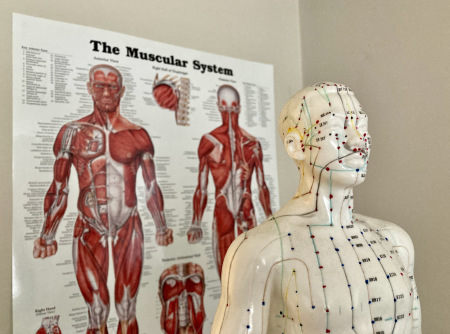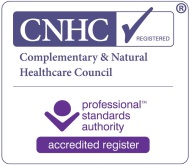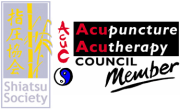TCM Acupuncture or Dry Needling Acupuncture
Which is Right for You ?
In the past 30 years I have been studying, practising and teaching Acupuncture and Soft Tissue Therapy.
I am a
trained and registered Traditional Acupuncturist and the two main styles of Acupuncture I practise, are Traditional Chinese Medicine (TCM) Acupuncture and a more contemporary and Western approach of
Trigger Point Acupuncture, also known as Dry Needling.
Depending on
each person, their individual symptoms and their treatment preference, I use TCM Acupuncture and Shiatsu bodywork or Dry Needling and Soft Tissue Therapy to treat a wide variety of health conditions
and muscular dysfunctions.
Let me
explain and clarify the two different styles and their uses.
What is TCM Acupuncture ?
TCM Acupuncture is part of, and based on, the principles and philosophy of Traditional Chinese Medicine (TCM).
TCM
views the body as an interconnected system, influenced by the flow of vital energy.
TCM
forms a complete system of traditional medicine and health care, a holistic and humanistic approach to understanding health and illness.
It
incorporates not just Acupuncture, but also Cupping and Moxibustion, Shiatsu and bodywork, diet and herbal medicine, exercise and lifestyle.
It
has been used as mainstream medicine in China and East Asian countries for many thousands of years.
Today it is used extensively in a hospital-based system or as alternative-complimentary treatment alongside modern Western medicine.
Acupuncture points are chosen according to a traditional diagnosis. Then, very thin, single-use, sterilised needles are inserted at specific points at strategic locations
along the energy lines or meridians, in order to address a wide range of conditions. The exact location is decided on the basis of the assessment of each person's presentation of
symptoms.
The
aim of this form of acupuncture is to stimulate and rebalance the body’s energy and activate the body’s natural healing response.
Practitioners are trained over several years in the complex theory of Traditional Chinese Medicine and in the diagnostic and clinical skills of traditional Acupuncture
techniques.
What is TCM Acupuncture used for ?
Acupuncture can be used for a wide range of specific acute and chronic conditions, and for more general
symptoms of poor health and conditions that have no medical explanation.
As
Traditional Chinese Medicine is based on an in-depth understanding of the body’s energy flow, the inter-relationship between internal organ functions and its external manifestations in the meridian
system. Acupuncture can be used not just for muscular conditions (TCM meridian problems), but also for the treatment of internal ailments (TCM organ function problems).
Most
commonly-treated symptoms are chronic pain conditions, internal ailments of digestive, respiratory and menstrual functions, as well as stress-related and emotional problems, including sleeping
difficulties, depression, anxiety, general fatigue and low energy.
Overall, the
World Health Organisation (WHO) recognises acupuncture as an effective treatment for many conditions and diseases.
Above all, TCM does not just address the person’s symptoms but also the person’s underlying constitution
and energetic imbalance.
This means,
it does not just allow symptomatic relief from some health problems, but looks to address the underlying cause of a problem.
How does TCM Acupuncture work ?
The explanation of
Traditional East Asian Medicine’s effectiveness is based on an energetic model, rather than on the biochemical model of Western medicine.
Ancient
oriental physicians recognised that vital energy circulates along a specific system of energy pathways throughout the body and links all of the body's parts and
functions.
This
energy’s quality, strength and free flow determines a person’s physical, mental and emotional heath and vitality.
In energetic terms, if for some reason the energy flow is blocked, weak or excessive, some minor symptoms can develop, which if not rectified, can continue to develop into more serious conditions,
illness or disease.
The aim of
TCM Acupuncture is to correct the flow of the body’s energy by inserting needles to specific, selected points along the network of meridians lines to enhance the flow of
energy.
TCM
Acupuncture can remove energy blockages in the meridian lines that caused muscular aches or pains, stimulate the flow of energy in the body and help regulate internal organ functions,
promoting health and eliminating the ‘dis-ease’.
It's
important to note that TCM Acupuncture is a complex system, and the effects of acupuncture can vary depending on the individual and the condition being treated.
What is Dry Needling or Trigger Point Acupuncture ?
Dry Needling or Trigger
Point Acupuncture is based on Western neurophysiological principles, which is often referred to medical acupuncture and it is practiced within a Western medical framework.
Using
sterilised, single-use Acupuncture needles, Dry Needling technique focuses on targeting specific overly tight and tender points in the muscle fibres, called myo-fascial Trigger
Points.
This
approach is more localised and primarily focuses on musculoskeletal conditions, addressing muscular pain and soft tissue dysfunction.
In order to
treat specific musculo-skeletal pain and dysfunction, a comprehensive, soft tissue, physical assessment is necessary to identify the specific Trigger Points in the affected, malfunctioning muscles
tissue.
Trigger
points can be found in various muscles throughout the body but most commonly found in the neck, shoulder and upper back muscles.
The aim of
Dry Needling is to de-activate Trigger Points in the muscles for the management of neuro-musculo-skeletal and myo-fascial pain and impairments.
In the last
couple of decades, in the UK, Trigger Point Acupuncture or Dry Needling is widely practiced by physical therapists (e.g., physiotherapists, osteopaths,
chiropractors).
Most Dry
Needling training is taught as short courses, or weekend seminars, and dry needling is not regulated.
What is Dry Needling or Trigger Point Acupuncture used for ?
Dry Needling or Trigger
Point Acupuncture can be used for all sorts of muscular-related issues and dysfunction.
Trigger
Points (knots or tight spots) can develop as a result of various factors, including chronic muscle strain of repetitive one-sided activities, poor posture or sedentary lifestyle, as well as muscle
tension from physical, mental or emotional stress.
These
discrete hyper-irritated nodules in the taut bands of hardened muscles disrupt normal muscle function, restrict range of motion, produce chronic or acute, local and referred pain, along with other
symptoms.
Using
Acupuncture to release or de-activate a Trigger Point in a muscle can release muscular tension and spasm, alleviate pain, improve blood flow and muscle functionality.
Most common
treated symptoms are acute and chronic pain conditions, overuse injuries and postural problems, back pain and trapped nerves, whiplash injuries and neck stiffness, headaches and jaw problems, joint
pain and reduced mobility.
The aim is
to alleviate pain, promote tissue healing, restore its normal movements, return bio-mechanical functionality and improve overall physical well-being.
Used safely
and skilfully, these techniques are effective and powerful additions to soft tissue therapy, making the hands-on treatments even more effective.
How does Dry Needling or Trigger Point Acupuncture work ?
Trigger Point Acupuncture or Dry Needling works by targeting and de-activating Trigger Points within the affected and malfunctioning muscles tissue.
Fine, sterilised and single-used Acupuncture needles are carefully and precisely directed to over-stimulate the Trigger Points, causing a local “twitch
response”, which is an involuntary contraction of the muscle fibres.
These reflexes (“twitch response”) is believed to help to de-activate the Trigger Points.
The de-activation of the Trigger Points produces a reflex relaxation in the muscle tissue itself, reduces muscle tightness and improves both function and
performance of the muscle tissue.
It encourages blood flow and triggers the release of inflammatory substances to the treated area, initiating a natural healing process.
Trigger Point Acupuncture can trigger the release of natural pain-relieving substances, such as endorphins, initiating a natural pain-relief
process.
The use of Acupuncture needles on Trigger Points can influence the nervous system by stimulating sensory nerves, enhancing the communication between the muscle
and the brain, leading to neurophysiological responses that initiate changes in muscle tone, muscle reflexes and the inhibition of pain signals.
Immediately after treatment, direct results and changes to the body can begin to be observed and felt by the therapist and patient.
Conclusion
Both styles of Acupuncture have their uses and when applied in the right way they can
produce effective treatment results.
Broadly speaking, Trigger Point or Dry Needling Acupuncture style can be seen as a sub-category modality of TCM Acupuncture.
All Trigger Points are acupuncture points, but not all acupuncture points are Trigger Points.
It is important to note that TCM Acupuncture is part of a complex diagnostic system and can be used to treat a wide variety of health conditions.
Dry Needling Acupuncture on the contrary, is fairly simple in its theory and application and is used to treat musculoskeletal conditions.
The effects of Acupuncture or Dry Needling can vary depending on the individual and each person’s individual symptoms.
If you have never had Acupuncture or you are wondering whether to try a Dry Needling session or start a course of Acupuncture treatments, please do not hesitate to
contact me and discuss any questions you may have.




